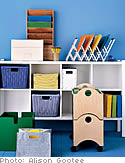Wait! It Was Here a Minute Ago

Can't find your passport? The warranty for your camera? The receipt for those too-small Jimmy Choos? Organized papers means less anxiety, less clutter and more control. Plus, you'll never have to keep shoes you don't want just because you couldn't find the receipt. Unless you already have a system that's at least 75 percent effective, I recommend starting from scratch.
Pick the Must-Haves
Determine what's critical, instead of trying to figure out what to get rid of, and change your mind-set. Suddenly, filing is not about storage but about finding what you need when you need it. Build your system around the pieces of paper are you often looking for, worried about or constantly referring to, whether it's medical records, take-out menus or school forms.
Weed Out the Maybes
Lug all your papers to one central location (any space with a large work surface will do) and sort them, one by one, into filing folders. Scratch passive headers like "Bills Due" in favor of hard-to-ignore names like "Maintain Good Credit."
Next, divide the folders into three to five broad categories. For example: Finance (receipts, investment and bank statements), Family (vital documents; medical, education and career records), Lifestyle (travel plans, hobby info, articles of interest). Traditional A-to-Z systems can be confusing because related files often end up under different letters.
Snazzify
One reason people fail to file is that it's boring. Try adding zip to your system.
How long should you hold on to receipts, records, and date books? Get Julie's special chart.
Pick the Must-Haves
Determine what's critical, instead of trying to figure out what to get rid of, and change your mind-set. Suddenly, filing is not about storage but about finding what you need when you need it. Build your system around the pieces of paper are you often looking for, worried about or constantly referring to, whether it's medical records, take-out menus or school forms.
Weed Out the Maybes
- Eighty percent of the stuff we file never gets looked at again. Not sure what to save? Ask yourself these questions—if you don't answer yes, toss it.
- Are there tax/legal reasons to keep it?
- Will it help me complete a project I'm working on right now?
- Do I have time to do anything with this piece of paper (e.g., product solicitations)?
- If I ever needed it again, would it be hard to get from someone else?
- Is the information up-to-date?
- Would my work/life change if I didn't have it?
- Articles, clippings or recipes you haven't looked at in five years
- Bad quality photos or ones you simply don't like
- Business cards from people whose names you don't recognize
- Expired coupons
- Expired insurance policies
- Expired warranties and service contracts or instructions for items you no longer own
- Invitations to past events
- Junk mail
- Old catalogs, greeting cards and grocery receipts
- Outdated schedules
- Receipts for non-tax-deductible items
- Road maps you haven't referred to in ten years
- Solicitations from charities you don't intend to give to
- Unread magazines more than three months old
Lug all your papers to one central location (any space with a large work surface will do) and sort them, one by one, into filing folders. Scratch passive headers like "Bills Due" in favor of hard-to-ignore names like "Maintain Good Credit."
Next, divide the folders into three to five broad categories. For example: Finance (receipts, investment and bank statements), Family (vital documents; medical, education and career records), Lifestyle (travel plans, hobby info, articles of interest). Traditional A-to-Z systems can be confusing because related files often end up under different letters.
Snazzify
One reason people fail to file is that it's boring. Try adding zip to your system.
- Color-coding reduces misfiling and stimulates your thinking—whenever you see a green folder, you might immediately think of money.
- Straight-line filing, with the tabs one behind the other, is not only easier on the eye but simpler to maintain than alternating tab positions.
- Make sure you keep your files in an area that's comfortable to work in—have at least two big drawers or boxes and a comfy chair nearby.
How long should you hold on to receipts, records, and date books? Get Julie's special chart.



